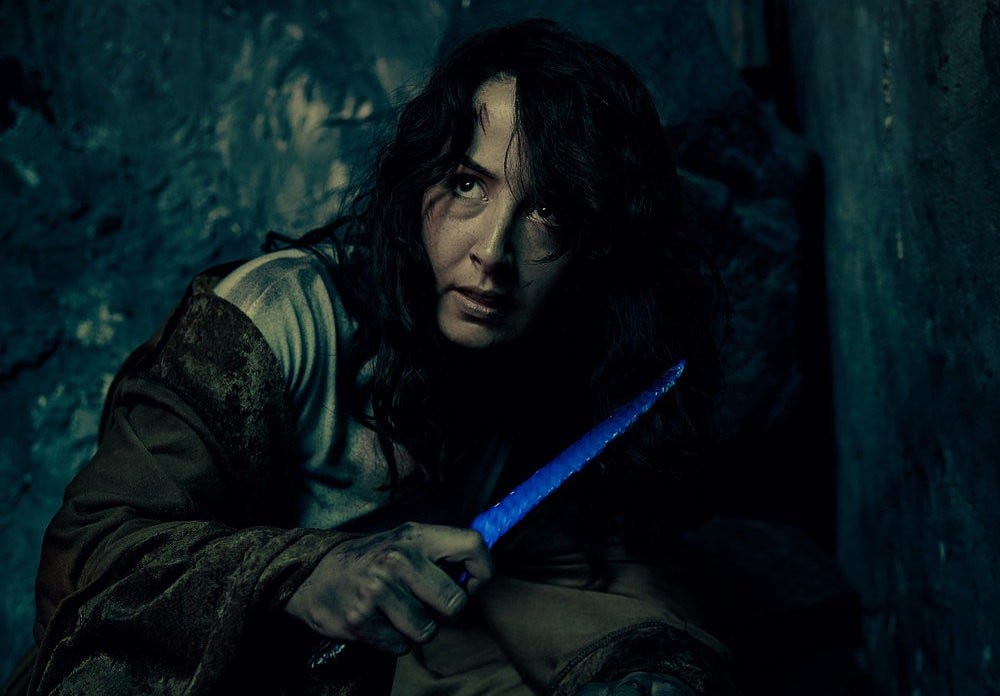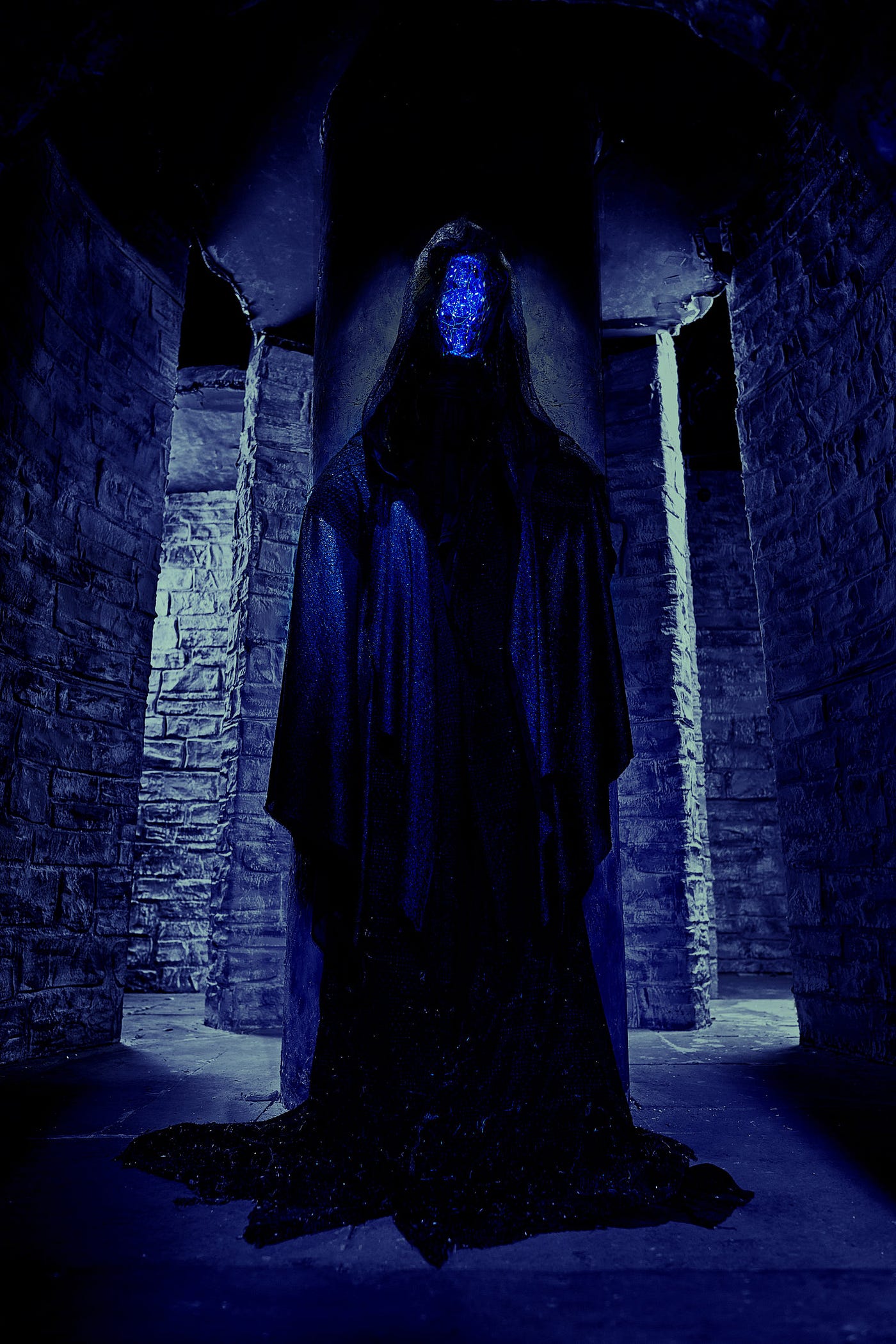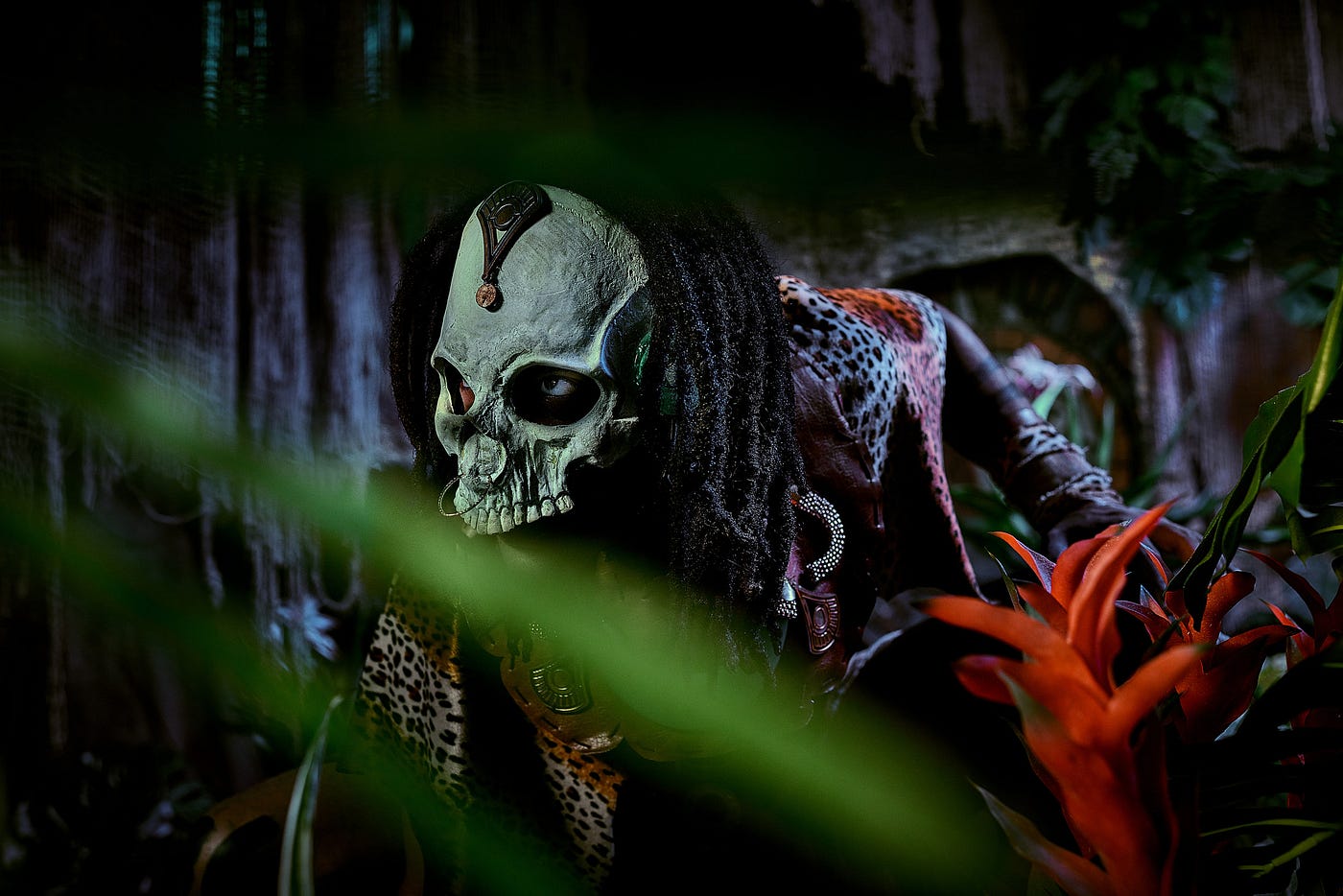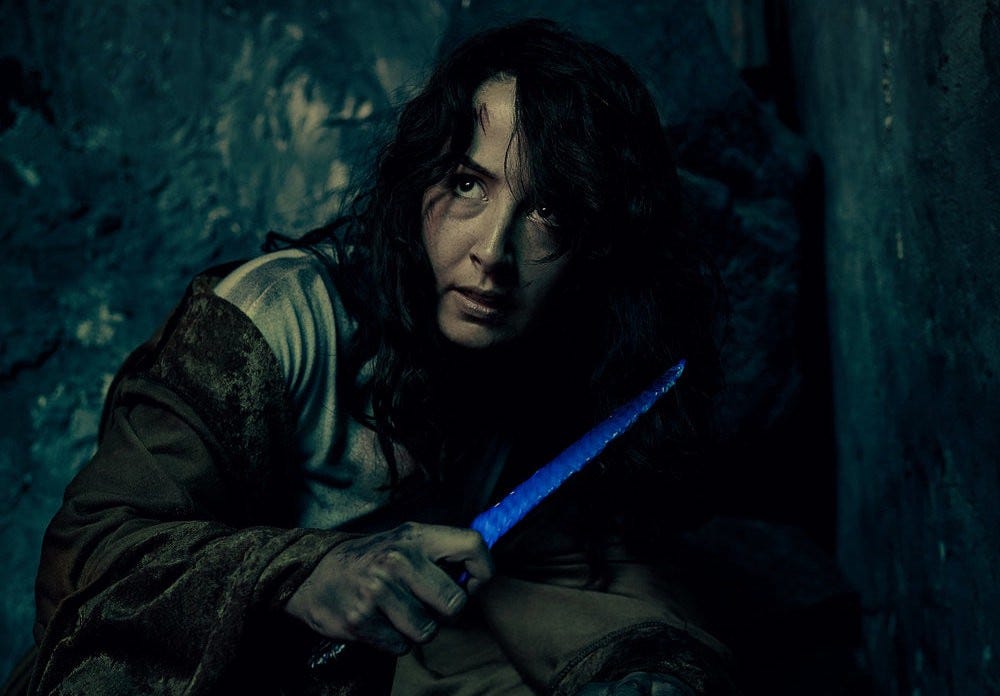
A look at the Delusion spring extension and an interview with director Jon Braver
One of the greatest gifts our childhood imagination gives us is the ability to go into any space and find an adventure there, boundless and expansive and intricate. You evade danger and fight bad guys (or good guys, if you were that kid), and live fully in a world that doesn’t exist, but feels like it could. Delusion: The Blue Blade gives that experience back to you, only with a considerable upgrade to the production values.
A departure from Delusion’s previous horror experiences, The Blue Blade is a classic adventure story — one with plenty of shocks, surprises, and (light) scares — that sends attendees on a journey through time, from a war zone to an ancient jungle shrouded in mist and numerous stops in between, as they hunt for a mysterious artifact and are hunted, in turn, by mysterious, terrifying spectres.

As a new initiate to a secret society of explorers and archaeologists, you are tasked with finding a missing colleague and the legendary Blue Blade. Your first task is to find, and follow, a potential lead. He is the first of a cast of distinctive, memorable characters who guide you along your path, encouraging exploration of the space and cleverly prompting audience participation that spurs the story along as necessary. The path itself leads you up and down hallways, stairways, hidden passageways, and into a number of ingeniously designed and dressed sets which, both times I have gone, elicited numerous moments of verbal — or at least audible — awe and delight from adult audience members. Myself included.
The show originally opened in October, and is back with additional content for a four week run. If you missed it the first time around, I cannot stress enough that you should not miss it again. The Director’s Cut features some clever touches of detail that enhance and clarify the story and the character’s relationships, and adds a major scene at the end of the experience that deepens the story and sets the ending up to be… more than it was, let’s say.
Delusion has excelled for years at crafting larger narrative journeys around their elaborate haunts which elevate them above the usual anxiety-dread-catharsis thrills of a typical horror experience. You never simply “escape” a monster or a bad guy, you always feel as though you orchestrated your own escape, won a battle, solved a clue, or in some other way earned your ending while pursuing a clear, story driven goal, personal to whatever role you’re inhabiting in the world of the show. With Blue Blade, moments of anxiety or dread are used to punctuate the story, but aren’t the point of the experience. Primarily, you get to experience the discovery and curiosity and urgency of being an adventurer on a quest.
You get to be Indiana Jones. It’s great.
I hesitate to describe in too much detail any part of the show, because discovering each new environment, and the characters who greet you in them, is not only a joy but is integral to the experience. All I can say is, for an optimal experience, pay attention, listen closely, and let your imagination run wild.
We were invited to sit with director/mastermind Jon Braver after our excursion, and pick his brain about the show.
Note: This conversation is a) full of spoilers and b) below, edited for length and clarity.
SPOILERS BELOW!

No Proscenium (NP): This is such a classic adventure story, there are so many elements that people grew up with and loved, it’s very Indiana Jones and there’s this futuristic tech aspect as well. How do you piece those together in a physical space?
Jon Braver (JB): It originated as really an homage to [Raiders of the Lost Ark], that’s kind of how I always wanted to do something like. The first time I found this venue, about two and a half years ago, I didn’t like it, it was too small for what I wanted to do but it was a different story, and I was ideating over the idea of a Raiders theme, I was driving by this place again 2 years later and for some reason the idea of an unassuming frontage of the theater, stepping into it and being in a Mayan jungle and being like, how the hell did this happen? I love that contrast.
So I said let’s give it another shot, and I was like it’s too small, it’s still too small, but after talking with my production designer and my tech advisor, Ian and Kevin, they told me obviously there’s a lot you can do with lighting and set pieces and design and darkness so I thought, let me take another look at the space and walk through, and each space spoke to me about a different era. Every room felt like a different era, and that big, open theater space, that sort of black box area that you can do anything you want with it, I thought we can have an expanse within there. So that fed into the whole time-traveling story.
So these guys assured me that the idea of transporting yourself in these different spaces, they could achieve that.
NP: The show feels like it’s just a couple little degrees away from being a great show for kids or young teenagers. It’s an interesting mix because you have some pretty scary imagery, but at the same time if I’m like a 12 year old, this would be everything I could ever want in a show. Is that something you thought about while making it, and in terms of marketing it or encouraging a certain audience to come?
JB: Yeah, after fiveyears of strict 21+, I knew as I was doing this, as I was writing it I think kids would really enjoy this, too, like 13 and up. And at the same time I knew we’d get some shit about — “This was terrifying every year, and it wasn’t as scary this time!” So I knew we’d have to weather the storm of people saying this isn’t scary enough, but I didn’t give a shit. It’s just like, let’s evolve and change and do other things, and we’ll go back to the other stuff, too, we’ll do another 21 and over show. It’ll be terrifying. But this one — It’s funny, I have a 10 year old daughter, and we just watched Raiders recently. And the idea of bringing her into this world and watching this classic story, just seeing her face watching this movie, it was insane. The whole time we were watching the movie I was just looking at her! It was so cool. So, I was like let’s do something kids can enjoy, and opening here I was like let’s give it a shot and try to open it up to 13 and up.
Last weekend we had a few kids come in, like 14 and 15, you should’ve seen them come out [at the end of the show]. It was crazy. I’ve never seen a reaction like it. And that’s one of my favorite parts is seeing everyone reverting to a kid when they come back out, it’s really cool to see. It’s sort of a goal of mine to get people to stop being boring adults and come back and enjoy this kind of things.

NP: What was your intent with this revised, extended version? What did you set out to do that was different from what you showed in October?
JB: There were a lot of ideas that we wanted to do from the beginning that we weren’t able to achieve budget wise. Still, this is our most expensive endeavor, ever, so the idea to come back was, I’ve always loved the idea of having the stand off between the younger Evelyn and older Evelyn. And due to numerous boring reasons that I won’t go into we couldn’t achieve that in the fall show. So I’ve been dying to get Evelyn back and to actually see her, live. So that was the impetus to come back and do something different, and there are a few little changes here and there.
A lot of people come multiple times, the first show is just so overwhelming, there’s so much stuff going on, you don’t really get all the layers of the story. We changed some things, but I could have literally done nothing and then you would’ve come through the second time and be like “That felt completely new!”.
NP: Who was your favorite character to write?
JB: I do love them all, but I’d say… One of my favorite things about writing any kind of story is when I get so excited about something, and I’m writing a scene, and they’re doing something in my mind, and then I have to leave, I feel like that character’s frozen in time, and they’re dying to finish the scene so I’ll rush back and try to finish the story. And when I start typing again, they literally in my mind start moving again, and it’s such a cool feeling and I had that feeling with Carrick. Carrick was a really cool, fun character to play with. I don’t know which of you went through his path and activated him, but the moment of him coming to life and standing in front of you is just really cool. I’m hoping to do a feature film based on this stuff, and his relationship’s really cool with Evelyn, their partnership and then their split over time, which we don’t get into terribly in this story. And I love this guy Stanfeld in the beginning. He’s sort of my — who’s that guy from Raiders? With the burnt hand? Arnold something. Stanfeld is great, because he’s multilayered, you find out he’s not exactly who he says he is. I love them all.
We wanted to something where Carrick goes down into the jungle with you, and then the giant stone creature takes him out, and he does like a whole C-3PO where his head goes flying off, sparking and rolling on the ground, but I was like, I’m not sure we can pull that off. That’s — talk about a character I really like, that one was like, let’s make a character that in the beginning you’re like “what the hell is this thing?” and then it joins your quest for a little bit. And it was kind of an homage to Bioshock.
NP: Big Daddy!
JB: Yeah, Big Daddy.
NP: The sound that the Keepers make is scary. How did you make it?
JB: There is sound design built into it, but the actors accentuate it, and each actor brings their own voice to it. Sound design is like half the story to me, I spent a lot of time with my assistant director Victor and Katie Joss, the other sound designer. We score the whole thing. We pull in all these weird creepy sounds, and figure out where they’re gonna come from and how it’s gonna blend in with the actor. How sound will envelope the entire space so it will feel as if it’s coming from everywhere. I love doing sound design.
My concern at the end with Evelyn was, her voice is supposed to echo throughout time, throughout the temple and all that, and we try to have it directional, where she’s blocked, so hopefully it came across that it was coming from her.

NP: Have you used the same production designers for Delusion’s shows?
JB: Yes, Kevin Williams. He’s a master designer for these kinds of things. I write the script, he reads it, then throws up all over it and then designs it.
NP: Did you study a lot about time travel, because essentially we end up in a loop, right?
JB: You end up in a loop, yeah. I read a couple time traveling books, and I lost my mind for a couple months. I mean, no joke, I fell into a weird space. I was like this is too trippy for me. I couldn’t write anymore, I had writer’s block, and at some point I was like — forget the physics of time travel, don’t think too much about all that stuff that people won’t care too much about, except super die hard time travel fans.
NP: Will this get the VR treatment?
JB: Yeah, we talked about doing like a 15 minute version of Delusion with The VOID, so we’ll see, I don’t know.
Delusion: The Blue Blade — Director’s Cut runs through March 17. Tickets are $95–185.
NoPro is a labor of love made possible by our generous Patreon backers: join them today!
In addition to the No Proscenium web site, our podcast, and our newsletters, you can find NoPro on Twitter, Facebook, YouTube, Instagram, in the Facebook community Everything Immersive, and on our Slack forum.
Office facilities provided by Thymele Arts, in Los Angeles, CA.




















Discussion